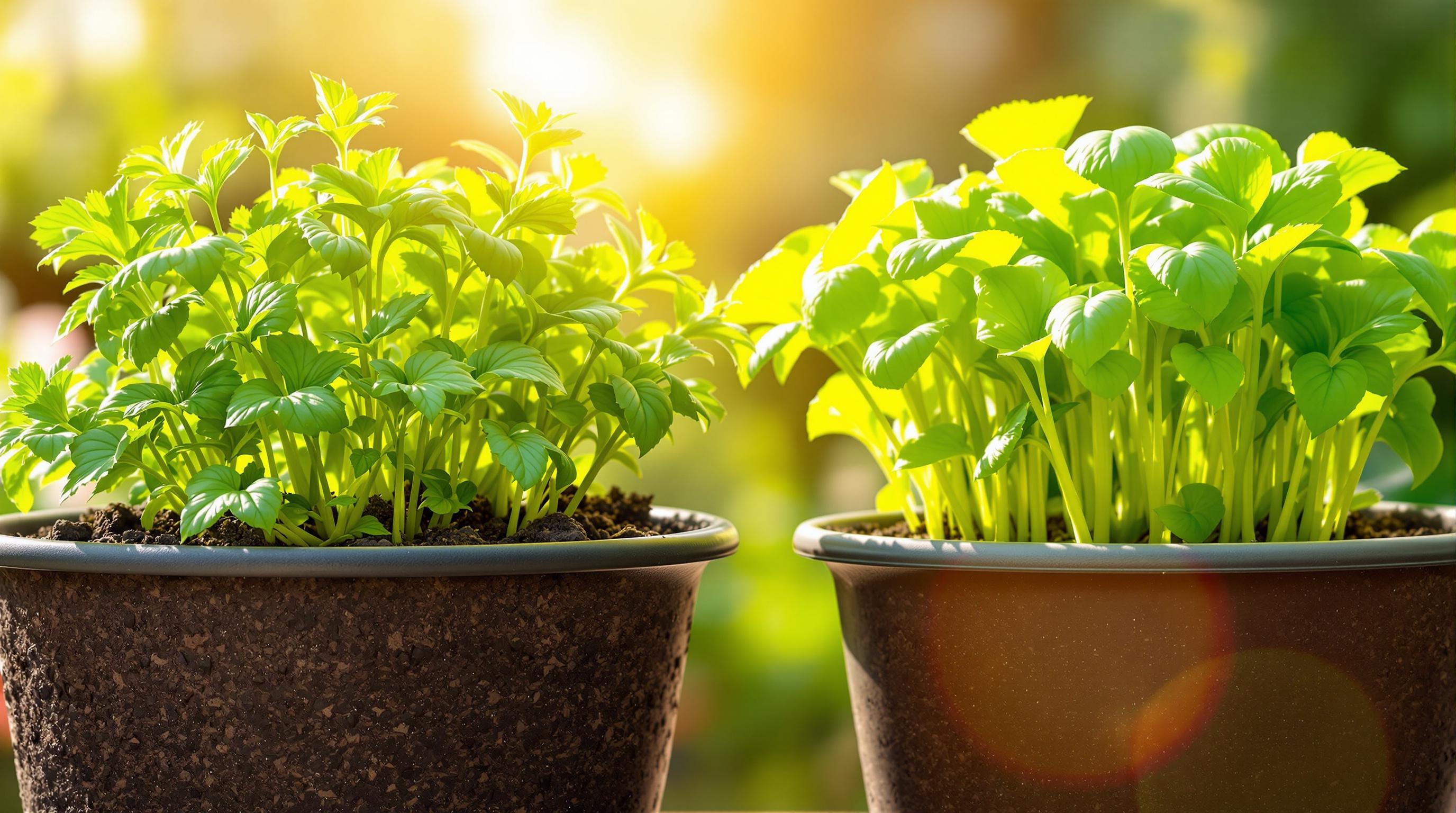Struggling to decide between organic and synthetic nutrients for your garden? Here's a quick guide to help you make the best choice for your plants and the environment.
- Organic Nutrients: Derived from natural sources like compost and manure. They release nutrients slowly, improve soil health, and are eco-friendly.
- Synthetic Nutrients: Lab-made for immediate absorption and precise control. Ideal for hydroponics and fast-growing plants.
Key Considerations:
- Your growing method: Hydroponics or soil-based
- Plant types and growth stages
- Environmental impact
- Gardening goals: Quick harvest or long-term soil health
Quick Comparison Table:
| Characteristic | Organic Nutrients | Synthetic Nutrients |
|---|---|---|
| Nutrient Release | Slow and steady | Immediate and fast-acting |
| Soil Health | Improves structure and microbes | Minimal impact |
| Cost | Higher upfront, lasts longer | Lower upfront, frequent use |
| Hydroponic Use | Less suited | Ideal |
| Environmental Impact | Lower | Higher |
Pro Tip: Combine both for the best results. Use organic nutrients to build soil health and synthetic nutrients for quick boosts during critical growth stages. Tailor your approach to Australia's unique climates and water needs for thriving plants.
How to Select a Fertilizer - Organic vs. Synthetic
Organic vs Synthetic Nutrients: Basic Differences
Organic and synthetic nutrients vary in their makeup, how plants absorb them, and their impact on the environment - key considerations for gardeners deciding which to use.
Organic Nutrients: What You Should Know
Organic nutrients come from natural sources like compost, animal manure, and mineral deposits. These nutrients rely on microbes to break them down, creating a thriving ecosystem in the soil.
Here are some key points:
- Gradual Release: Nutrients are released slowly as microbes process them.
- Improves Soil: Enhances soil structure and encourages beneficial microbes.
- Eco-Friendly: Minimises chemical runoff and supports biodiversity.
"Our mission is to promote sustainable gardening practices to instil a flow-on effect in the wider environment." - Green Genius
Organic nutrients not only nourish plants but also improve the overall health of the soil, making them a great choice for long-term gardening success. On the other hand, synthetic nutrients are tailored for immediate plant uptake, which suits controlled environments.
Synthetic Nutrients: What You Should Know
Synthetic nutrients are lab-made and designed to deliver precise amounts of essential elements directly to plants.
| Aspect | Characteristics | Best Suited For |
|---|---|---|
| Availability | Instantly available | Fast-growing plants, hydroponics |
| Precision | Exact nutrient ratios | Controlled environments |
| Application | Easy to measure and adjust | Systems needing precise control |
These nutrients fully dissolve in water, providing an instant nutrient boost and making them ideal for hydroponic or soilless setups. While organic nutrients focus on long-term soil health, synthetic options excel in delivering quick results and addressing deficiencies in controlled systems.
How to Pick the Right Nutrients
Garden Goals and Environmental Impact
Choose nutrients based on what you want to achieve in your garden and how they affect the environment. Organic nutrients help improve soil health and support eco-friendly gardening. On the other hand, synthetic options are better for quick, controlled plant growth. Make sure your choice matches the specific growth needs of your plants.
Plants and Their Growth Needs
Different plants and growth stages call for different nutrients. For hydroponics, synthetic nutrients provide fast absorption and precise control. In soil-based gardens, organic nutrients are ideal for improving soil health over time, but you can also use synthetic options for immediate results.
Growing Method Considerations
Your growing method plays a big role in nutrient selection. Hydroponic systems work best with water-soluble nutrients that allow precise control. Soil gardens, however, can benefit from a mix of organic and synthetic nutrients to address both short-term and long-term plant needs.
At Green Genius, we specialise in sustainable gardening and can guide you in choosing the nutrient solutions that fit your garden’s needs and methods.
sbb-itb-28a8941
Side-by-Side Nutrient Comparison
Organic and synthetic nutrients each bring unique benefits to gardening. Here's a breakdown to help you decide which fits your needs.
Quick Reference Chart
| Characteristic | Organic Nutrients | Synthetic Nutrients |
|---|---|---|
| Nutrient Release | Slow-release | Fast-acting, immediately available |
| Cost per Use | Higher upfront cost, lasts longer | Lower initial cost, frequent use needed |
| Application Method | Mixed with soil or compost | Dissolved in water for direct use |
| pH Control | Naturally buffers pH levels | Requires close monitoring |
| Soil Health Impact | Improves soil structure and supports microbes | Minimal impact on soil quality |
| Hydroponic Suitability | Less compatible with soilless systems | Ideal for hydroponic setups |
| Environmental Impact | Lower environmental footprint | Can have a higher environmental impact |
| Nutrient Consistency | Natural variation | Precise and consistent ratios |
Synthetic nutrients are fully water-soluble, making them ideal for hydroponics and efficient water use. In Australia’s unpredictable climate, it’s important to adapt your nutrient choices based on seasonal shifts. Synthetic nutrients may require closer monitoring during extreme weather, while organic options provide a steadier nutrient release.
Understanding these differences can help you combine both types for the best results in your garden.
Using Both Types Together
Combining the benefits of organic and synthetic nutrients can give your plants the best of both worlds. A hybrid approach ensures your plants get what they need for healthy growth while maintaining soil vitality.
Base Layer + Boost Strategy
Incorporate organic nutrients into your soil for long-term health, and use synthetic nutrients during growth spurts or critical stages. Adjust this approach based on Australia's seasonal variations for optimal results.
Seasonal Integration
- Summer: Use organic nutrients as a base and supplement with synthetic nutrients during hot periods to support rapid growth.
- Winter: Increase synthetic nutrients when soil temperatures drop below 15°C to maintain nutrient availability.
- Spring/Autumn: Strike a balance between organic and synthetic nutrients to support growth and flowering stages.
Hydroponic Hybrid Method
In hydroponic systems, synthetic nutrients should be the mainstay. Complement them with organic additives like enzymes, beneficial microbes, or foliar sprays to enhance plant health.
Regardless of your method, regular monitoring is essential for success.
Smart Mixing Guidelines
- Use organic and synthetic nutrients at least 24 hours apart to avoid chemical interactions.
- Regularly check pH levels, aiming for a range of 6.0 to 6.5.
- Start with half the recommended dose to prevent overfeeding.
- Observe plant responses for 7–10 days before making adjustments.
Container Gardens
For plants in containers, mix organic nutrients into the soil at the start. During growth, use diluted synthetic feeds to provide an extra boost. Keep an eye on plant health, especially leaf colour and growth patterns, and adjust your feeding schedule as needed. Maintaining detailed records can help fine-tune your approach over time.
Tips for Growing in Australia
Tailor your nutrient approach to suit Australia's varied climates and water challenges.
-
Smart Water Management
Australia's diverse climates make efficient water use crucial. Hydroponic systems are a great choice, as they use much less water than traditional methods. Be precise when measuring synthetic nutrients in hydroponics to minimise waste and ensure plants absorb what they need. -
Adjusting for Regional Climates
Different parts of Australia require specific nutrient strategies. In tropical regions with high humidity, watch for fungal growth and reduce nutrient strength during wet seasons. In arid areas, tweak nutrient concentrations to account for faster evaporation. For temperate zones, align your nutrient schedule with seasonal changes for the best results. -
Caring for Native Plants
Native Australian plants often need fewer nutrients. When growing these species, use a diluted nutrient mix and monitor their response to find the right balance. This approach not only benefits the plants but also encourages sustainable gardening practices. -
Eco-Friendly Choices
Base your feeding program on organic nutrients, saving synthetic options for critical growth phases. This approach supports both plant health and the environment. -
Managing Water Restrictions
During periods of water restrictions, focus on conserving water while delivering essential nutrients. Use organic amendments to retain soil moisture and apply synthetic nutrients with precision. Regularly check your system's performance to ensure efficiency. -
Temperature Considerations
In hot weather, apply nutrients early in the morning or late in the evening to avoid stress on plants. Store synthetic nutrients in a cool, dark place to maintain their effectiveness. -
Local Water Quality
For hydroponic systems, choose nutrient solutions that match your area's water quality. In regions with hard water, opt for formulations that prevent nutrient lockout to keep plants thriving. -
Adapting to Seasonal Changes
Australia's distinct seasons affect how plants absorb nutrients. Adjust your nutrient routine as the seasons change to ensure plants get what they need at the right time.
Final Tips and Next Steps
Deciding between organic and synthetic nutrients doesn’t have to be complicated. Organic nutrients are a great choice for eco-friendly gardening, while synthetic nutrients offer faster growth and more precise control.
Here’s what to do next:
- Review Your Setup: Choose nutrients that suit your growing method - synthetic nutrients work well for hydroponics, while organic options fit traditional gardens.
- Set Clear Goals: Identify what you want to achieve, whether it’s growing vegetables or cultivating native plants.
- Start Simple: Begin with a basic nutrient plan and tweak it based on how your plants respond.
If you’re into hydroponics, keep an eye on these key factors:
- pH levels
- Nutrient concentration
- Plant health
- Water usage
For tailored advice, Green Genius offers consultation services to create nutrient plans that align with your garden’s needs. They also run the Green Genius Garden Club, which provides regular tips and exclusive access to specialised products.
Many successful gardeners use a mix of both nutrient types. Organic nutrients can form the backbone of your program, with synthetic nutrients added during specific growth phases or when plants need a quick boost.
Finally, make sure your nutrient strategy is suited to Australia’s unique climate and water conditions. This will help you maintain healthy, thriving plants.

